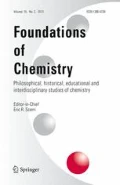Abstract
As part of a series of contributions on patterns in the periodic table, the relationships among the transition metals are examined here in a systematic manner. It is concluded that the traditional method of categorizing transition elements by group or by period is not as valid as by using combinations thereof. From chemical similarities, it is proposed that the transition metals be considered as the [V–Cr–Mn] triad; the [Fe–Co–Ni–Cu] tetrad; the [Ti–Zr–Hf–Nb–Ta] pentad; the [Mo–W–Tc–Re] tetrad; and the [Ru–Os–Rh–Ir–Pd–Pt–Au] heptad. Silver does not fit neatly in anywhere and is better linked with thallium.
Similar content being viewed by others
References
Brock, W.H.: William Crookes (1832–1919) and the Commercialization of Science, p. 79. Ashgate, Surrey (2008)
Douglas, B.E.: The lanthanide contraction. J. Chem. Educ. 31, 598–599 (1954)
Griffith, W.P.: The periodic table and the platinum metals. Platinum Met. Rev. 52, 114–119 (2008)
Habashi, F.: Metals: typical and less typical, transition and inner transition. Found. Chem. 12, 31–39 (2010)
Keller, R.N.: The lanthanide contraction as a teaching tool. J. Chem. Educ. 28, 312–317 (1951)
Lee, J.D.: Concise Inorganic Chemistry, 5th edn. Chapman & Hall, London (1996)
Nicholls, D.: The Chemistry of Iron, Cobalt and Nickel (Pergamon Texts in Inorganic Chemistry 24). Pergamon Press, Oxford (1975)
Pourbaix. M.: Atlas of Electrochemical Equilibria in Aqueous Solution, 2nd English edn. National Association of Corrosion Engineers, Houston (1974)
Pyykkö, P., Desclaux, J.-P.: Relativity and the periodic system of elements. Acc. Chem. Res. 12, 276–281 (1979)
Rayner-Canham, G.: Isoelectronic series: a fundamental periodic property. Found. Chem. 11, 123–129 (2009)
Rayner-Canham, G.: Isodiagonality in the periodic table. Found. Chem. 13, 121–129 (2011)
Rayner-Canham, G.: Periodic patterns: the group (n) and (n + 10) linkage. Found. Chem. (in press)
Rayner-Canham, G., Oldford, M.: The chemical ‘knight’s move’ relationship: what is its significance? Found. Chem. 9, 119–125 (2007)
Restrepo, G., Llanos, E.J., Mesa, H.: Topological space of the chemical elements and its properties. J. Math. Chem. 39, 401–415 (2005)
Schweizer, G.K., Pesterfield, L.L.: Aqueous Chemistry of the Elements. Oxford University Press, Oxford (2010)
Schwerdtfeger, P.: Relativistic effects in properties of gold. Heteroat. Chem. 13, 578–584 (2002)
Sneath, P.H.A.: Numerical classification of the chemical elements and its relation to the periodic system. Found. Chem. 2, 237–263 (2000)
Venkataraman, D., et al.: A coordination geometry table of the d-block elements and their ions. J. Chem. Educ. 74, 915–918 (1997)
Weeks, M. E., Leicester, H. M.: Discovery of the Elements, 7th edn. J. Chem. Educ., Easton (1968)
Wikipedia: http://en.wikipedia.org/wiki/Noble_metals. Accessed 31 Dec 2010
Author information
Authors and Affiliations
Corresponding author
Rights and permissions
About this article
Cite this article
Rayner-Canham, G. Relationships among the transition elements. Found Chem 13, 223–232 (2011). https://doi.org/10.1007/s10698-011-9117-x
Published:
Issue Date:
DOI: https://doi.org/10.1007/s10698-011-9117-x




